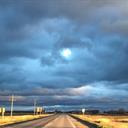Which are the largest reservoirs of fresh water on earth?
Fresh water is characterized by having low concentration of dissolves salt. It does not include mineral-rich water. Out of all the water on Earth, saline water in oceans, seas and a saline ground water, make up about 97.2% of it. Only 2.8% is fresh water. Three quarters of all fresh water on Earth is glacier ice, 0.5- 0.75% as fresh ground water and soil moisture, and less than 0.01% of it as surface water in lakes, swamps, and rivers. A glacier is a large perennial accumulation of ice, snow, rock, sediment and water originating on land and moving down on slope under the influence of its weight and gravity. The largest glaciers cover almost all of Antarctica and Greenland.
Glaciologists recognize types of glaciers as continental ice sheets, ice caps, ice shields, outlet or pied mont glaciers, ice shelves and rock glaciers. Ice caps can be greater than 50,000 square kilometers in area, while ice sheets are even larger. Ice caps and ice sheets completely cover the land surface.
During the last ice age, the glacial epoch or Pleistocene epoch, the large ice sheets covered much of North America. Malaspina glacier in Alaska is one of the most famous example of world's largest piedmont glacier.
More Info:
www2.usgs.gov










